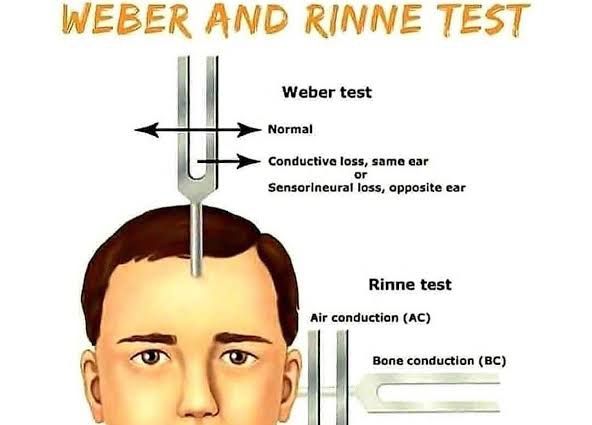
Pathophysiology of Conduction Deafness and Nerve Deafness
1. Conduction Deafness
Conduction deafness, also known as conductive hearing loss, occurs when sound waves are not effectively transmitted through the outer ear canal to the eardrum and the ossicles of the middle ear. This type of hearing loss can result from various factors, including:
- Obstruction: Cerumen impaction (earwax buildup) or foreign bodies can block sound transmission.
- Infection: Otitis media (middle ear infection) can cause fluid accumulation, impairing sound conduction.
- Eustachian Tube Dysfunction: Failure of the Eustachian tube to equalize pressure can lead to fluid buildup in the middle ear.
- Structural Abnormalities: Malformations or damage to the ossicles (ossicular chain) can prevent proper vibration transmission.
- Otosclerosis: A condition characterized by abnormal bone growth around the stapes bone, leading to fixation and reduced mobility.
The pathophysiological mechanism involves a disruption in the mechanical transfer of sound energy from air to fluid within the cochlea, resulting in diminished auditory perception.
2. Nerve Deafness
Nerve deafness, or sensorineural hearing loss, arises from damage to the inner ear structures (cochlea) or auditory nerve pathways. The causes include:
- Hair Cell Damage: Exposure to loud noises can lead to irreversible damage to hair cells in the cochlea.
- Aging: Presbycusis is age-related hearing loss due to degeneration of sensory cells and neural pathways.
- Genetic Factors: Hereditary conditions may affect cochlear function or nerve integrity.
- Infections: Viral infections such as mumps or measles can damage auditory structures.
- Ototoxic Medications: Certain drugs can adversely affect cochlear function.
The underlying mechanism involves a failure in converting mechanical vibrations into electrical signals that are transmitted via the auditory nerve to the brain. This results in a reduced ability to perceive sounds clearly.
Rinne’s and Weber’s Tests
Rinne’s and Weber’s tests are clinical assessments used to differentiate between conduction deafness and nerve deafness.
1. Rinne’s Test
In Rinne’s test, a tuning fork is struck and placed on the mastoid process behind one ear (bone conduction). Once no longer heard, it is moved next to the external auditory canal (air conduction).
- In normal hearing or nerve deafness, air conduction is better than bone conduction (positive Rinne).
- In conduction deafness, bone conduction is better than air conduction (negative Rinne).
2. Weber’s Test
Weber’s test involves placing a vibrating tuning fork at the center of the forehead.
- In normal hearing or nerve deafness, sound lateralizes equally in both ears.
- In cases of conduction deafness, sound lateralizes toward the affected ear due to enhanced bone conduction.
- In nerve deafness, sound lateralizes away from the affected ear since there is diminished perception on that side.
Mechanism of Specific Conditions
1. Otosclerosis
Otosclerosis is a condition characterized by abnormal bone remodeling in the middle ear that primarily affects the stapes bone. It leads to fixation of this bone within the oval window of the cochlea. The exact cause remains unclear but may involve genetic predisposition and environmental factors. As a result of this fixation, sound vibrations cannot efficiently transmit into the inner ear leading to conductive hearing loss initially; however, as it progresses and affects cochlear function directly or indirectly through changes in fluid dynamics within the inner ear structures, it may also lead to sensorineural hearing loss.
2. Meniere’s Disease
Meniere’s disease involves an abnormal accumulation of endolymphatic fluid within the inner ear structures leading to increased pressure (endolymphatic hydrops). This condition results in episodes characterized by vertigo (spinning sensation), tinnitus (ringing in ears), fluctuating hearing loss, and a sensation of fullness in the affected ear. The underlying mechanism involves disruption in fluid homeostasis affecting both sensory cells within the cochlea responsible for hearing and those within vestibular structures responsible for balance.
3. Transient Deafness on Change of Altitude
Transient deafness during altitude changes typically occurs due to Eustachian tube dysfunction which prevents equalization of pressure between the middle ear and external environment during rapid elevation or descent (such as during flying or driving through mountains). When pressure differences occur rapidly without adequate equalization via swallowing or yawning mechanisms facilitated by Eustachian tube opening, discomfort ensues along with temporary conductive hearing loss until pressures stabilize.
Masking Effect: Blockage of Air Conduction upon Bone Conduction
The masking effect refers to how obstruction in air conduction influences perceived bone conduction thresholds. When air conduction is blocked—such as by cerumen impaction—the ability for sounds conducted through air diminishes while bone-conducted sounds may still be perceived normally. However, if both pathways are obstructed simultaneously (e.g., severe conductive loss), it may mask any residual auditory perception via bone conduction alone because there’s insufficient stimulus for comparison against background noise levels.
In summary, understanding these mechanisms allows for accurate diagnosis and management strategies for patients experiencing different types of hearing loss.







